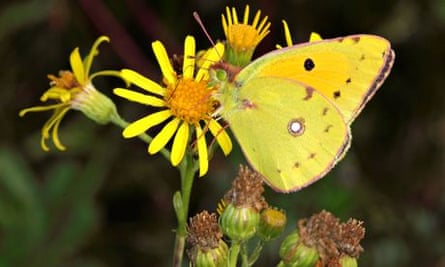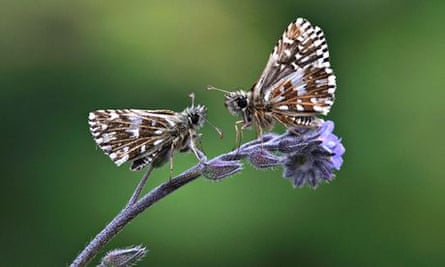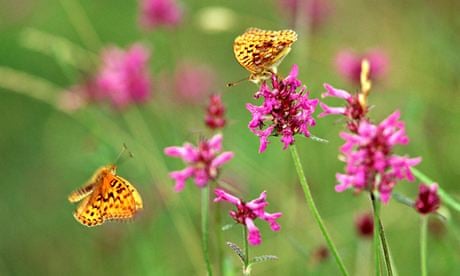Butterflies returned to the skies last year with four-fifths of British species increasing after the worst summer on record, but overall numbers were still well below average.
An unusually sunny midsummer gave respite to rare species threatened with extinction following a disastrous 2012, in which fewer butterflies were recorded by volunteers and scientists than at any time since records began.
Targeted conservation work also helped populations of the endangered high brown fritillary, which increased numbers by 133% in 2013, and the Lulworth skipper, up by 162%, according to the UK Butterfly Monitoring Scheme (UKBMS) that began in 1976.
Common garden species such as the small tortoiseshell, which had suffered a dramatic decline after a run of unreliable summers also rallied, also recovered. The small tortoiseshell improved its numbers by more than 200% in 2013 to record its best year for a decade.
Fine weather and gentle winds also brought large numbers of small tortoiseshells, peacocks and whites over from the continent, with last year also proving to be a notable summer for the distinctive clouded yellow. Butterfly recorders for the UKBMS counted 1,900 of these powerful migrants, mainly across southern England.
But overall numbers were still well below average with last year the 14th worst summer since monitoring began. The exceptionally cold spring was a struggle for butterflies that usually emerge in April and May, with the endangered pearl-bordered fritillary falling by 22% compared to 2012 and numbers of the grizzled skipper falling by 45% to a historic low.

Rare species such as the Duke of Burgundy continued to struggle after suffering local extinctions during the recent run of bad summers. Such specialist species are finding it difficult to recolonise lost ground.
"After seven really bad years we saw a good emergence last summer," said Dr Tom Brereton of Butterfly Conservation, which runs the monitoring scheme with the Centre for Ecology & Hydrology. "But there's only so much recovery that can be done in one year – we need a breeding season beyond that to get things going."
This spring has been encouraging with large numbers of small tortoiseshells, brimstones and peacocks successfully hibernating as adult butterflies and emerging across the country.
Butterfly populations always fluctuate because of the weather but the data collected by thousands of volunteers and scientists shows that more than 70% of Britain's 59 species are experiencing long-term declines, due to habitat loss, industrial farming and climate change.
"The majority of warmth-loving butterflies should be benefiting from climate change because in Britain they are at the northern edge of their range but that's outweighed by the negative effects of habitat loss and fragmentation," said Brereton.
Some British butterflies are spreading northwards, but climate change is happening so quickly that some species are struggling to adapt fast enough.

In some cases, there is a developing mismatch between a butterfly's life-cycle and the availability of food plants or nectar as crucial plants flower before a butterfly emerges from its pupae.
Other species find themselves stranded on tiny islands of protected land or nature reserves because habitat is so fragmented, unable to move to more suitable territory as the weather becomes too hot or dry. Extreme weather events – including droughts and the record wet winter – also make small residual populations of butterflies more vulnerable to extinction.
Dr Marc Botham, ecologist at the Centre for Ecology & Hydrology, said: "Annual changes are largely associated with the weather. However, the data show that a number of species have been significantly declining over the last 38 years. This highlights the importance of maintaining long-term monitoring, reliant on the immense dedication of thousands of volunteers, to determine species and habitats of conservation priority."

Comments (…)
Sign in or create your Guardian account to join the discussion